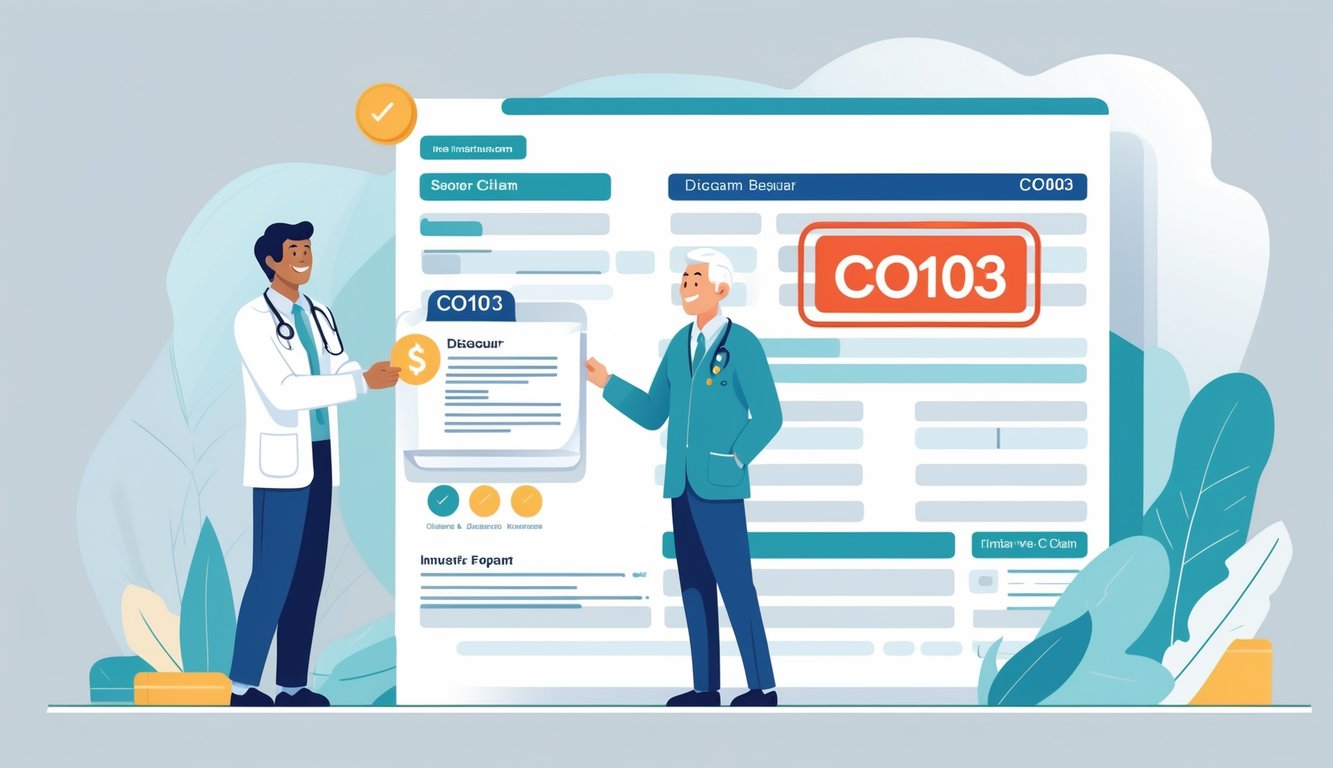Dealing with insurance claim denials can be frustrating, especially when you encounter codes that aren’t immediately clear. If you’ve received a CO103 denial code on a medical claim, you’re looking at an issue related to provider promotional discounts.

A CO103 denial code indicates that the insurance company is not accepting a promotional discount that was applied by your healthcare provider, such as a senior citizen discount. This code has been in use since January 1995 and remains a common reason for claim adjustments in medical billing.
Understanding this denial helps you address the issue properly. When a provider offers special pricing that isn’t recognized by your insurance company, it can affect how your claim is processed. You may need to contact your provider’s billing department to determine how this discount impacts your financial responsibility and what steps to take next.
Understanding CO103 Denial Code
When reviewing your explanation of benefits or denial forms, you may encounter the CO103 code. This specific code relates to promotional discounts offered by healthcare providers that insurance companies may not recognize or accept during claim processing.
Definition of CO103 Denial Code
CO103 is a Claim Adjustment Reason Code that indicates “Provider promotional discount (e.g., Senior citizen discount).” When this code appears on your claim, it means the insurance company has identified that the healthcare provider applied a promotional or special discount to the service.
Insurance companies use these standardized codes to explain why they adjusted or denied a claim. The CO prefix stands for “Contractual Obligation,” which means the adjustment relates to contractual agreements between providers and payers.
Unlike some denial codes that indicate errors, CO103 simply acknowledges a discount was applied. This doesn’t necessarily mean something is wrong with your claim.
Provider Promotional Discount Explained
Provider promotional discounts are special pricing offers that healthcare facilities extend to certain patient groups. These discounts reduce the standard fee for medical services based on specific criteria or marketing initiatives.
Common types include:
- Senior citizen discounts: Reduced rates for elderly patients
- Prompt-pay discounts: Savings for patients who pay at the time of service
- Military or veteran discounts: Special rates for current or former service members
- Hardship discounts: Reduced fees based on financial need
These discounts are at the provider’s discretion and aren’t always recognized by insurance companies. When a provider submits a claim with a promotional discount, the insurer may process it differently than expected, triggering the CO103 code.
Common Examples of Provider Discounts
Healthcare providers offer various promotional discounts that can trigger a CO103 code. Here are examples you might encounter:
Senior Citizen Discounts: Many practices offer 10-20% off for patients over 65, especially for services not fully covered by Medicare.
Seasonal Promotions: Some providers run special pricing on certain procedures during specific times of year, such as vision centers offering LASIK discounts in January.
Bundle Discounts: When you receive multiple services together, providers might discount the total cost compared to having each service separately.
Cash Payment Incentives: Providers often reduce fees by 5-15% when you pay in cash rather than billing insurance.
These discounts can be beneficial to you as a patient but may create complications with insurance processing if not properly documented in the billing system.
Reasons for CO103 Denials

When you receive a CO103 denial code, it typically relates to promotional discounts that weren’t properly handled during the billing process. Insurance companies have specific rules about how these discounts should be applied and documented.
Eligibility and Coverage Issues
Insurance plans have strict eligibility requirements for promotional discounts. Many payers don’t recognize provider-initiated discounts, especially senior citizen discounts, unless they’re part of your contract.
Your patient might not qualify for the discount according to the payer’s guidelines. For example, some plans require patients to be a specific age (typically 65+) to receive senior discounts.
Some promotional discounts apply to non-covered services only. If you applied a discount to a covered service, the payer may deny the claim with a CO103 code.
Verify eligibility before offering discounts by checking:
- Patient’s age and status
- Plan-specific discount policies
- Whether the service is covered under the plan
Contractual Obligations and Discount Agreements
Your contract with insurance companies often dictates which discounts you can offer. Applying unauthorized discounts violates your contractual obligations.
Many payer contracts specifically prohibit offering discounts that reduce patient responsibility without prior approval. This is especially true for managed care plans.
Key contractual issues include:
- Missing discount authorization from the payer
- Offering discounts that conflict with agreed reimbursement rates
- Failing to document the discount according to contract terms
Review your provider agreements carefully before implementing any promotional discount program. Some contracts require specific documentation or prior notification.
Billing Errors and Claim Submission Mistakes
Incorrect coding frequently triggers CO103 denials. Using the wrong modifier or failing to indicate the discount properly on the claim form causes processing errors.
Common billing mistakes include:
- Not documenting the discount amount correctly
- Using inappropriate adjustment codes
- Failing to include required supporting information
The timing of your discount application matters too. Applying discounts after claim submission often results in denials.
Double-check your claim forms before submission. Ensure the discount is clearly indicated and properly calculated. Keep detailed records of all promotional discounts for audit purposes.
How to Resolve CO103 Denial Code Issues
When facing CO103 denial codes related to provider promotional discounts, you need to take specific actions to get your claims processed correctly. Insurance companies often reject these discounts, but with the right approach, you can address these issues effectively.
Claim Adjustment and Reprocessing
Start by reviewing your original claim to confirm the promotional discount was properly documented. Many CO103 denials occur because the discount wasn’t clearly identified in the initial submission.
Contact the payer’s provider services department to understand their specific policies regarding promotional discounts. Some insurers have special requirements for how these discounts should be reported.
Consider removing the promotional discount from the claim and rebilling at the standard rate. In many cases, this is the simplest solution, especially if the patient has already received their discount benefit.
Update your practice management system to flag promotional discounts that specific payers don’t accept. This proactive approach prevents future denials.
Appeal Procedures and Required Documentation
Prepare a formal appeal letter that clearly explains the nature of the promotional discount and why it should be allowed. Reference any contract provisions that support your position.
Required documentation for appeals:
- Copy of original claim
- Explanation of Benefits (EOB) showing the denial
- Proof of medical necessity
- Practice discount policy documentation
- Patient agreement forms
Submit your appeal within the payer’s specified timeframe. Most insurers allow 30-180 days from the date of the EOB to file an appeal.
Track your appeal status and follow up if you don’t receive a response within 30 days. Persistence often pays off with complex denial codes.
Corrected Claims and Supporting Modifiers
Resubmit the claim with appropriate modifiers that indicate the service was discounted as part of a promotional program. The GY modifier may be appropriate in some cases to indicate a statutorily excluded service.
Ensure you’re using the correct place of service codes and that your taxonomy codes match your provider type. Inconsistencies can trigger additional denials.
Apply modifier 59 when appropriate to distinguish the discounted service from other procedures performed on the same day.
Important billing tips:
- Always include the full charge before the discount
- Clearly mark the discount amount in the appropriate field
- Use the comment section to explain the promotional discount program
Remember to update your fee schedules regularly and communicate any promotional discount programs to your billing staff and clearinghouse partners.
Impact of Provider Promotional Discounts on Claims

Provider promotional discounts like senior citizen discounts can significantly affect how claims are processed and paid. These discounts modify the expected payment amounts and can change what patients owe.
Payment Adjustments and Reductions
When providers offer promotional discounts, the claim amount is adjusted downward before processing. This appears as code CO103 on remittance advice documents. The payment adjusted reflects the negotiated discount that was applied to the service.
Insurance companies typically process these claims based on the discounted amount, not the original charge. For example, if you offer a 20% senior discount on a $100 service, the adjusted claim amount becomes $80.
This affects your reimbursement in several ways:
- Your expected payment is reduced
- Coinsurance calculations change
- Deductible applications are based on the lower amount
Some payers may have specific rules about how these discounts interact with their fee schedules. Always check payer policies to understand how promotional discounts affect your contracted rates.
Coordination of Benefits and Patient Responsibility
Promotional discounts can complicate coordination of benefits when patients have multiple insurance policies. The primary insurance processes the claim with the discount applied, which then affects what information is sent to secondary payers.
When calculating patient responsibility, you must apply the discount before determining:
- Co-payment amounts
- Patient portions of coinsurance
- Remaining balances
For Medicare patients, special rules may apply. Medicare might require that the same discount be available to all patients regardless of payer.
Remember to clearly document discount policies in your financial agreements with patients. This helps prevent confusion about why certain charges appear differently on statements versus insurance explanations of benefits.
Best Practices to Avoid CO103 Denials
Preventing CO103 denial codes requires careful attention to how you document and apply promotional discounts. Insurance companies have specific rules about provider-offered discounts that can impact your reimbursement.
Accurate Documentation and Coding
When offering promotional discounts like senior citizen rates, clearly document the specific discount in the patient’s record. Always verify if the patient’s insurance plan accepts provider-initiated discounts before applying them.
Use the appropriate billing modifiers when submitting claims that involve discounted services. Some payers require specific modifiers to indicate a promotional discount was applied to the procedure code.
Include detailed notes in the claim explaining the nature and amount of the discount. This transparency helps prevent misunderstandings during the adjudication process.
Review your charge capture process to ensure discounts are properly calculated and applied. Double-check that your billing system correctly reflects the discount without creating coding inconsistencies.
Reviewing Discount Agreements and Policies
Regularly audit your discount policies against current payer requirements. Many insurance companies update their policies on provider discounts annually.
Create a reference sheet of which payers accept promotional discounts and under what circumstances. Some may accept senior discounts but reject other promotional offers.
Obtain written confirmation from insurance companies about their discount policies. This documentation can help if you need to appeal a CO103 denial.
Train your billing staff specifically on discount documentation procedures. Staff should understand how different payers handle the assignment of benefits when promotional discounts are applied.
Consider consulting with a billing specialist to review your discount structure. They can help ensure your promotional offers comply with insurance requirements and avoid unnecessary denials.
Frequently Asked Questions
Medical billing professionals often encounter CO103 denials when processing claims that involve provider promotional discounts. Understanding how to handle these denials properly can save time and ensure proper reimbursement.
What are common reasons for receiving CO103 denial code in medical billing?
The CO103 denial code typically appears when a provider has offered a promotional discount, such as a senior citizen discount, but hasn’t properly documented or communicated this to the insurance company.
These denials may occur when the discounted amount doesn’t match what the insurer expects to see on the claim.
Sometimes, the denial happens because the discount wasn’t applied according to the provider’s contract with the insurer.
How can providers address a CO103 denial code to ensure proper reimbursement?
You should first verify that the discount was appropriate and correctly applied based on your practice’s promotional discount policies.
Review the patient’s eligibility for the specific discount and ensure it was documented properly in their file.
Submit a corrected claim with clear notation about the discount’s purpose and calculation method. Include supporting documentation that justifies the discount.
What steps should be taken when an insurer issues a CO103 denial code?
Contact the insurer’s provider relations department to understand their specific requirements for reporting promotional discounts.
Review your contract with the insurer to confirm if the promotional discount complies with their policies.
Gather all relevant documentation about the discount program and submit this information with your appeal or corrected claim.
What documentation is required to dispute a CO103 denial code related to a provider promotional discount?
You need to provide a copy of your practice’s written discount policy that was in effect when the service was provided.
Include proof that the patient qualified for the discount, such as age verification for senior discounts.
Submit an explanation of how the discount was calculated and applied to the specific claim in question.
Are there specific guidelines for applying promotional discounts to prevent CO103 denials in healthcare billing?
Create a written policy that clearly outlines all promotional discounts your practice offers and the criteria for eligibility.
Apply discounts consistently across all patients who qualify for them to avoid accusations of discrimination.
Document the discount clearly in the patient’s financial record and on the claim form using appropriate codes and modifiers.
Can a CO103 denial code be appealed, and what is the process for doing so?
Yes, CO103 denial codes can be appealed. Start by submitting a formal appeal letter to the insurance company.
Include all relevant documentation about your discount program, the patient’s eligibility, and how the discount was applied.
Follow up with the insurer’s appeals department within 30 days if you don’t receive a response. You may need to escalate to a supervisor if the appeal is denied.







